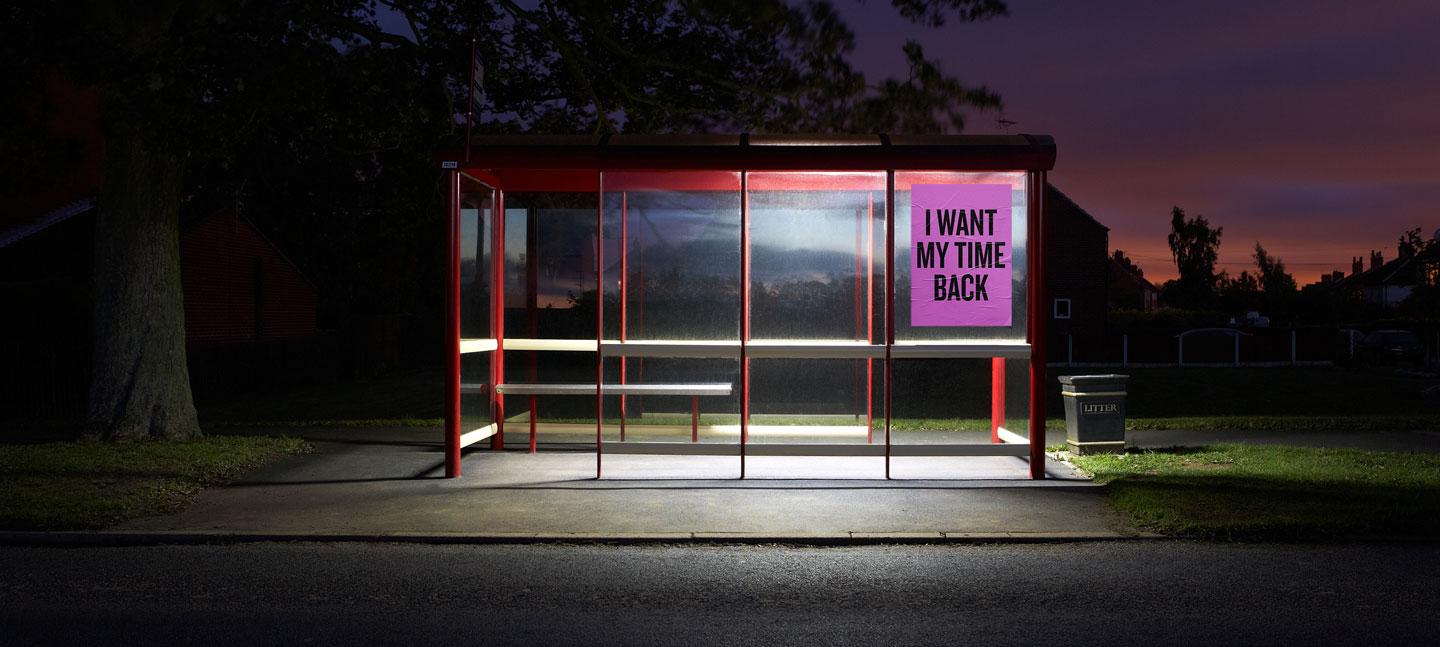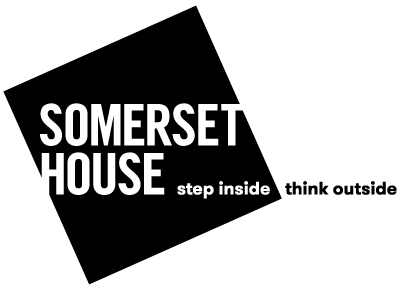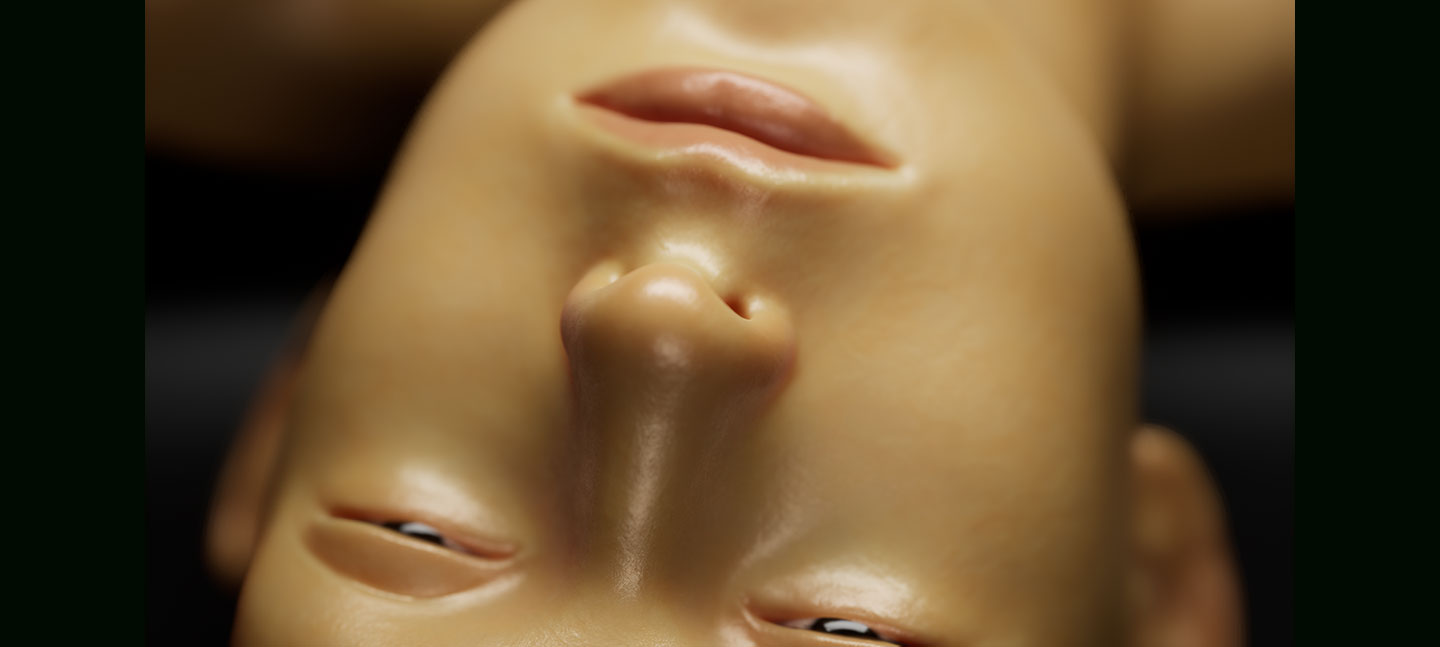
A wake-up call for our non-stop world
This autumn, Somerset House presents 24/7, a landmark exhibition examining our inability to switch off from our 24/7 culture, through a series of immersive works from some of today’s most exciting global artists.
Over 50 multi-disciplinary works have been brought together to explore the unrelenting pressure to produce and consume around the clock. The exhibition takes visitors on a 24-hour cycle from dawn to dusk through interactive installations and interrogations. It holds a mirror up to a society where complex systems are exerting control, causing us to sleep less and disrupting our instincts to daydream and pay attention to the world around us, and each other. Some of the works playfully suggest solutions, inviting visitors to unplug and unwind, from Japanese artist Tatsuo Miyajima’s meditative isolation chamber Life Palace (tea room) to Canadian artist Catherine Richards’ Shroud/Chrysalis I, where visitors can opt to be completely shrouded in a copper blanket, blocking out any electro-magnetic signals from devices such as smartphones.
Inspired by the book 24/7: Late Capitalism and the Ends of Sleep by New York-based art critic and essayist Jonathan Crary (Verso, 2013), it is the first time that a major multi-disciplinary exhibition has been dedicated to creative responses to this modern malaise.
Curated by Somerset House and Sarah Cook, contributors include Marcus Coates, Mat Collishaw, Douglas Coupland, Harun Farocki, Susan Hiller, Rut Blees Luxemburg, Katie Paterson, Pilvi Takala, and ten artists and designers from Somerset House Studios, including Iain Forsyth & Jane Pollard and Alexandra Daisy Ginsberg, some of whom have created new work especially for the exhibition.
This inability to switch off has become one of the most important issues of our time. Since 2010 we’ve added a full week (37 hours) to our working year, yet 200,000 working days are now lost annually due to insufficient sleep. Britain has become a nation of night owls, with almost half of the country (48%) regularly going to bed after 11pm. Living in the glow of blue light, people in the UK now check their smartphones, if averaged over 24 hours, every 12 minutes. These shocking statistics show how critical it is to understand better this pressing subject, which is increasingly considered a public health epidemic.
EXHIBITION OVERVIEW
The exhibition takes visitors on a journey from the cold light of the moon to the fading warmth of the sunset, through five principal zones (detailed below). With light installations by the acclaimed theatre lighting designer Lucy Carter, the zones are based around the tensions of life in a non-stop world. New technologies have blurred the boundaries between day and night, activity and rest, the human and the machine, work and leisure, the individual and the collective.
The exhibition’s five principal zones are listed below, each highlighting some of the artists’ works within:
Day and Night: The Wreckage of the Day
The beginnings of 24/7 life can be charted back to the Industrial Revolution, with workers rostered around the clock. The distinction between day and night has eroded, disrupting our bodies’ natural rhythms, something which seems to have intensified during the Information Age. Highlights include:
JOSEPH WRIGHT, ARKWRIGHT’S COTTON MILLS BY NIGHT
In the 1790s, Britain’s master of light and shadow painted a Derbyshire cotton mill, owned by Sir Richard Arkwright, inventor of the modern factory. It is believed to be one of the earliest depictions of British 24/7 culture, with workers made to do shifts around the clock.
ROMAN SIGNER, BETT
Swiss artist Roman Signer presents a film of himself fast asleep in bed, as a remote-controlled helicopter frenetically swoops and hovers above his head.
BENJAMIN GROSSER, ORDER OF MAGNITUDE
American artist Benjamin Grosser, who specialises in the cultural effects of software, has created a supercut of Facebook founder Mark Zuckerberg. Drawing on Zuckerberg’s every video appearance from 2004-2018, Grosser has extracted a few words that crop up regularly in his recordings: “more”, “grow” or utterances of numbers, humorously revealing what may be perpetually on Zuckerberg’s mind.
Activity and Rest: Sleep//Attentiveness
There is so much competition for our attention in today’s world that it can seem as if there are not enough hours to actually stop and sleep. As the CEO of Netflix has commented, “Our biggest competitor is sleep”. When we’re sleep deprived, our ability to pay attention reduces drastically and our productivity drops, creating new economies around self-tracking devices and other sleep aides, to supposedly help recover our attentiveness. Highlights include:
TATSUO MIYAJIMA, LIFE PALACE (TEA ROOM)
Japanese artist Tatsuo Miyajima has created a meditative isolation chamber, which individuals are encouraged to climb inside and within the blue glow of blinking LED numbers, drink in the passage of time.
IAIN FORSYTH & JANE POLLARD, SOMNOPROXY
Somerset House Studios artists Iain Forsyth & Jane Pollard stage immersive audio installation, Somnoproxy, a futuristic story of someone who offers services to sleep on behalf of wealthy executives who are too busy and stressed to get some shut-eye themselves. Visitors are invited to lie down in a large hotel bedroom to experience this state-of-the-art sonic escape from reality.
ALICE VANDELEUR-BOORER, JET SLAG
In the very early days of personal fitness tracking devices, British artist Alice Vandeleur-Boorer participated in a sleep deprivation scientific study. Living in a lab for 10 days, without natural light or any knowledge of the time, she was asked to advance her body clock by four hours every night. Her photographs and data graphs show the disorientating effects.
The Human and The Machine: Surveillance//Control//Acceleration
Technological advancements are accelerating our lives and humans try to keep up. There is a striking imbalance between the amount of data generated and shared, both actively by us and passively by global tracking systems, and the amount of time necessary to process it all. Yet our digital dependency shows no signs of abating any time soon, leaving a footprint that can forever follow us.
This section spotlights some of the origins to these developments, featuring objects from 19th-century philosopher Jeremy Bentham’s design for his Panopticon, a site of absolute surveillance, to the original Series 2 diary room chair from the seminal reality TV ‘experiment’ Big Brother. Highlights include:
NASTJA SÄDE RÖNKKÖ, 6 MONTHS WITHOUT
Nastja Säde Rönkkö spent her six-month Somerset House Studios residency living and working without the internet. She presents the constant trials and personal rewards of her project.
MAT COLLISHAW, THE MACHINE ZONE
British artist Mat Collishaw has created a new work for 24/7, based on the historic behavioural experiments of American psychologist B.F. Skinner. Six animatronic birds will move inside ‘Skinner boxes’, exploring the idea of random reward, which underpins the algorithms driving social media interactions and has been linked to our likelihood to become addicted to them.
HASAN ELAHI, NEW WORK FROM TRACKING TRANSIENCE
American artist Hasan Elahi was mistakenly put on a no-fly list after the events of 9/11, which led him to generate online systems to share personal data and photographic evidence of his whereabouts, at all times, with the FBI. Especially for the exhibition, he has mined this ongoing personal database to create new work which overwhelms the viewer with pictures of all the meals he’s eaten, beds he’s slept in and airports he’s flown to.
Work and Leisure: Work//The Commons
The workplace has become our playground, and vice versa, as business and leisure time have blurred, with more homeworkers and more coffee shops becoming working hubs than ever before. What had once been touted as the future of employment, the current gig economy has proven a honey trap for some; despite the illusion of greater flexibility and freedom away from the office, the reality can be precarious, requiring more time for work and less for rest and relaxation. It often leaves individuals in isolation, rather than part of a collective who can easily come together to champion workers’ rights. Highlights include:
PILVI TAKALA, THE STROKER
Last year, Finnish artist Pilvi Takala posed as a wellness consultant at Second Home, a fashionable East London co-working space for entrepreneurs and start-ups. She was supposedly the founder of a cutting-edge ‘personnel’ company, allegedly employed by Second Home to provide touching services in the workplace. A film in the exhibition shows the humorous, heartening and awkward responses to these touches.
HARUN FAROCKI, WORKERS LEAVING THE FACTORY
Named after the title of the first cinema film ever shown in public, German filmmaker Harun Farocki’s Workers Leaving The Factory compiles found films of workers outside factories, revealing their rituals and routines as soon as they have clocked off and get outside the gates, as a social group rather than a group of employees. The clips open a space which used to be widely seen in news and film reels, yet now is rarely witnessed.
TEGA BRAIN AND SURYA MATTU, UNFIT BITS
Australian artist Tega Brain and artist Surya Mattu reveal the hacks to cheat fitness tracking devices, such as Fitbit, in her project Unfit Bits. The simple DIY strategies trick wearable technologies into believing that people have engaged in more physical activity than they have, helping to produce data to qualify them for incentives from employers or insurers, even if they can't afford a high exercise lifestyle. Unfit Bits’ hacks highlight the unreliability of such data streams, on which we seem to increasingly depend.
The Individual and The Collective: Reset
Reset is the collective wake-up call for a change to current conditions. The immersive installations at the finale of the exhibition explore ideas to restore our natural rhythmic patterns of sleep and rediscover our capacity to daydream. Highlights include:
CATHERINE RICHARDS, SHROUD/CHRYSALIS I
Exhibition visitors are invited to be completely enclosed in a copper blanket. When wrapped, the visitor is 'unplugged'; still aware of their surroundings, capable of seeing and hearing through the fabric, yet protected from any electro-magnetic signals from devices such as smartphones. It could be the first time that a visitor has been truly disconnected from their devices.
ALEXANDRA DAISY GINSBERG, MACHINE AUGURIES
Somerset House Studios artist Alexandra Daisy Ginsberg presents a new orchestration of an AI-generated dawn chorus, highlighting the impact of 24/7 urban lifestyles on bird populations. This new work has been commissioned in partnership between Somerset House and design incubator A/D/O by MINI.
DAILY TOUS LES JOURS, I HEARD THERE WAS A SECRET CHORD
Montreal-based art and design studio Daily tous les jours invite visitors to unite with listeners around the world to hum the chorus of Leonard Cohen’s Hallelujah, to feel a collective resonance through this epic song. The presentation of this work is supported by the Québec Government Office, London.
Public installations and events
Somerset House will offer a number of free public installations around the site, and a lively event programme guided by the themes of 24/7 throughout the run of the exhibition.
HYPHEN LABS
Somerset House Studios artists Hyphen Labs have created a new photo booth, playing on the phenomena of contagious yawning. Hyphen Labs’ booth will confront visitors with pictures of people yawning and if they can’t resist following suit, they will be captured mid-yawn.
TEKJA, AWAKE
Somerset House Studios residents Tekja have built a new live data visualisation, which tracks insomnia and the peak hours when sleep is most longed for. The three-dimensional projection displays live data revealing the rhythms of sleeplessness worldwide and exploring the relationship between time and sleep in the connected 24/7 world.
DOUGLAS COUPLAND, SLOGANS FOR THE 21ST CENTURY
Canadian author and artist Douglas Coupland has created new slogans from his ongoing Slogans series, inspired by the themes of 24/7. The slogans will feature on colourful posters to be pasted around the Somerset House site, taking a humorous sideways look at this culture.
Events
NIGHT WALK OF NIGHT WORK, 14 NOVEMBER 2019
Tickets and Times to be announced in September
Somerset House Studios artist Eloise Hawser leads a night walk of London, discovering the hidden landmarks, stories, and workplaces of Fleet Street's historic 24-hour print industry alongside today’s digital 24/7 newsfeeds. Hawser’s practice explores the way we relate to architectural, mechanical, and electrical infrastructure.
24 HOURS IN UCHRONIA WITH HELGA SCHMID, 7 – 8 FEBRUARY 2020
Tickets and Times to be announced
Somerset House Studios artist Helga Schmid leads an experimental 24-hour event, centred around the discovery of new time scales. Uchronia (the temporal utopia) will feature special installations, conversations, screenings, performances and an exclusive out-of-hours exhibition viewing. All aim to address the 24/7 culture crisis through exploring alternative time structures in relation to our societal, natural and bodily rhythms.
HYPER FUNCTIONAL, ULTRA HEALTHY
Tickets, Dates and Times to be announced
Somerset House Studios’ series Hyper Functional, Ultra Healthy returns in the New Year for a special 24/7 edition. Through a programme of newly commissioned artworks and events, it takes an alternative and unconventional approach to the concept and practice of holistic wellness.
24/7 is supported by the world leader in lighting, Signify (formerly Philips Lighting) and The Adonyeva Foundation, which has generously contributed to numerous new commissions by Somerset House Studios artists.
24/7 CONTRIBUTING ARTISTS: Adam Chodzko, Addie Wagenknecht, Alan Warburton, Alexandra Daisy Ginsberg, Alice Vandeleur Boorer, Benjamin Grosser, Biome Collective & Joseph DeLappe, Cassie McQuater, Catherine Richards, Daily Tous Les Jours, Daniel Eatock, Douglas Coupland, Ed Fornieles, Erica Scourti, Esmeralda Kosmatopoulos, Étienne Jules Marey, Harun Farocki, Hasan Elahi, Heath Bunting, Humans since 1982, Hyphen Labs, Iain Forsyth and Jane Pollard, Inés Cámara Leret, John Butler, John Gerrard, JooYoun Paek, Joseph Wright of Derby, Julia Varela, Kateřina Šedá, Katie Paterson, Kelly Richardson, Kimchi and Chips, Lawrence Lek, Liam Young, Marcus Coates, Mark Thomas, Mat Collishaw, Michael Mandiberg, Nastja Säde Rönkkö, NONE Collective, Pierre Huyghe, Pilvi Takala, Roman Signer, Rut Blees Luxemburg, Sam Meech, Susan Hiller, Tatsuo Miyajima, Ted Hunt, Tega Brain and Surya Mattu, Tekja, Thomson & Craighead, Tyler Coburn, UBERMORGEN, Viktor IV
FOR PRESS ENQUIRIES, PLEASE CONTACT: press@somersethouse.org.uk/0207 845 4624
ADDITIONAL LISTINGS INFORMATION
Address: Somerset House, Strand, London, WC2R 1LA
Transport: Underground: Temple, Embankment / Rail: Charing Cross, Waterloo, Blackfriars
Website: www.somersethouse.org.uk
Somerset House Facebook: www.facebook.com/SomersetHouse
Somerset House Twitter: @SomersetHouse
Somerset House Instagram: @SomersetHouse
Hashtag: #247exhibition
NOTES TO EDITORS
ABOUT SOMERSET HOUSE
Inspiring contemporary culture
One of the city’s most spectacular and well-loved spaces, Somerset House is a new kind of arts centre in the heart of London, designed for today’s audiences, artists and creatives – an inspirational community where contemporary culture is imagined, created and experienced.
From its 18th Century origins, Somerset House has played a central role in our society as a place where our culture and collective understanding of the world is shaped and defined. In 2000, it began its reinvention as a cultural powerhouse and home for arts and culture today, creating unique and stimulating experiences for the public, bringing them into direct contact with ideas from the greatest artists, makers and thinkers of our time. Our distinctive and dynamic year-round programme spans the contemporary arts in all its forms, from cutting-edge exhibitions and installations to annual festivals, seasonal events in the courtyard including Film4 Summer Screen, Summer Series and Skate, and an extensive learning and engagement programme.
As well as welcoming over 3million visitors annually, Somerset House houses the largest and most diverse creative communities in the country – from one-person start-ups to successful creative enterprises including British Fashion Council, Dance Umbrella, Improbable Theatre, Hofesh Shechter Company, and Dartmouth Films. In 2016 we launched Somerset House Studios – a new experimental workspace connecting artists, makers and thinkers with audiences. Currently housing over 80 artists and Makerversity (a community of over 250 emergent makers), the Studios are a platform for the development of new creative projects and collaboration, promoting work that pushes bold ideas, engages with urgent issues and pioneers new technologies. www.somersethouse.org.uk
ABOUT SARAH COOK
Sarah Cook is a curator, writer and researcher based in Scotland. She is Professor of Museum Studies in Information Studies at the University of Glasgow. She is editor of the book INFORMATION (Documents of Contemporary Art, Whitechapel and MIT Press, 2016) and co-author (with Beryl Graham) of Rethinking Curating: Art After New Media (MIT Press, 2010; Chinese edition 2016). Sarah is one of the curators behind Scotland’s only digital arts festival NEoN Digital Arts and founder/curator of LifeSpace Science Art Research Gallery at the University of Dundee. Sarah has worked as curator of new media at BALTIC Centre for Contemporary Art, and in 2008 was the inaugural curatorial fellow at Eyebeam Art and Technology Center in New York.
Sarah has curated and co-curated international exhibitions of contemporary art and new media art worldwide, including: The Gig Is Up (2016) at V2_Institute for Unstable Media in Rotterdam; Right Here, Right Now (2015) at The Lowry in Salford; Alt-w (2014) at the Royal Scottish Academy, SSA Annual Exhibition in Edinburgh; Not even the sky: Thomson & Craighead (2013) for MEWO Kunsthalle in Memmingen; Biomediations (2013) for Transitio_MX_05, the festival of electronic arts and video in Mexico City; Mirror Neurons (2012) for National Glass Centre in Sunderland; Q.E.D. (2011) for the AND Festival in Liverpool; Untethered (2008) for Eyebeam in New York; Broadcast Yourself (2008) for AV Festival 08 in Newcastle; Database Imaginary (2004) and The Art Formerly Known As New Media (2005) both for the Walter Phillips Gallery, The Banff Centre, Canada.
ABOUT SIGNIFY
Signify (Euronext: LIGHT) is the world leader in lighting for professionals and consumers and lighting for the Internet of Things. Our Philips products, Interact connected lighting systems and data-enabled services, deliver business value and transform life in homes, buildings and public spaces. With 2018 sales of EUR 6.4 billion, we have approximately 29,000 employees and are present in over 70 countries. We unlock the extraordinary potential of light for brighter lives and a better world. We have been named Industry Leader in the Dow Jones Sustainability Index for two years in a row. News from Signify is located at the Newsroom, Twitter and LinkedIn. Information for investors can be found on the Investor Relations page.



